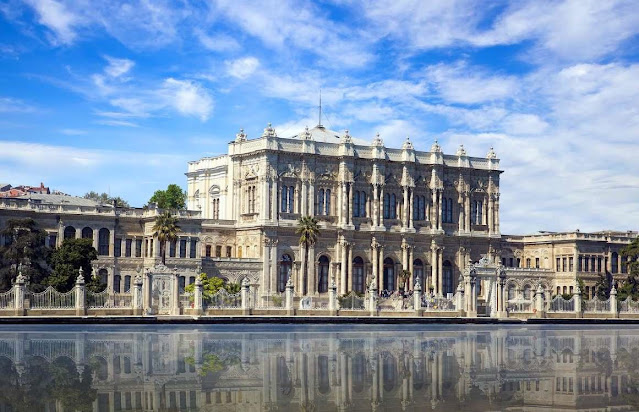Luxurious and gorgeous palaces in the world represent the nobility of royals. The common characteristics of these works are unlimited building expenditure.
You may also like:
- 7 royal palaces take you back to fairy dreams
- Impressed by the architecture of the world's 10 most beautiful temples and pagodas
Buckingham Palace, London, Britain: The Buckingham Palace is the abode of the Queen of the UK, built in 1703. This place is the administrative headquarter of the monarchy regime in the UK. Initially, it has the name Buckingham House, long afterward until 1820 just became the palace rebought by King George IV.
The palace has about 775 rooms, with 240 bedrooms (including the sleeping zone of royal, guests, and staff), 78 bathrooms, and 19 staterooms. Interiors inside the palace were decorated luxuriously in classy neo-class architecture. As a result, this place became the backdrop for many royal moments, the symbol of England.
Schonbrunn Palace, Vienna, Austria: The Schonbrunn Palace is one of the most famous places in the capital of Vienna. Initially, this place was designed as a royal rest home for the royal during hunting. Until century 17, the emperor Leopold repaired to return here becoming one of the biggest palaces in the world, with 1.441 very impressive rooms.
The vast palace holds many priceless treasures belonging to the Austrian royal family, especially sculptures mounted on ceilings or corridors. Inside are luxurious architecture, exquisitely painted ceilings, large mirrors, and chandeliers all fitted with sparkling crystals. As a result, Schonbrunn has been recognized by UNESCO as a World Heritage Site.
Versailles Palace, Versailles, France: Palace of Versailles (or Château de Versailles) located near Paris is a world famous place for its luxury and splendor. Built in the 17th century, Versailles was once home to the French royal family. Until the revolution in 1789, this place was occupied and deprived of many valuable assets.
Today the palace is almost completely restored, leaving only a few lost properties. A few rooms inside the palace are superiorly decorated compared to the rest, with sparkling chandeliers and lots of sculptures on two sides. It is estimated that inside the palace there are about 5,000 antique furniture items and 6,000 priceless paintings.
Dolmabahçe Palace, Istanbul, Turkey: This is considered one of the most luxurious places in the world, including 285 rooms and 46 large and small halls. This place used to be the headquarters of the Ottoman Empire. At the end of the 18th century, Emperor Abdulmecid I had to spend 14 tons of gold to plated the ceiling for the palace.
The design of the palace is mixed with Baroque, Rococo and Neoclassical styles, but also retains some details of traditional Ottoman architecture. Expensive materials such as Marmara marble and Egyptian plaster were used throughout the palace. Today it is partially open to visitors, and used for state ceremonies.
Forbidden City, Beijing, China: The Forbidden City is one of the most popular tourist attractions in China. This is a large complex with 90 palaces, 900 buildings, and 10,000 rooms, about 73 hectares wide. Built from 1406 - 1420 years, this place is the typical work of Chinese feudal style architecture.
During the feudal period, ordinary people were forbidden to go near the Forbidden City. Today, this place welcomes thousands of visitors every day. This sprawling palace complex has also been listed as the largest collection of ancient wooden architecture, recognized by UNESCO as a World Heritage Site.
Winter Palace, Saint Petersburg, Russia: The Winter Palace is a masterpiece of Baroque architecture in the city of Saint Petersburg, Russia. The palace has been restored many times, today's version was built from 1730 - 1837 in an area of 6 hectares. Outside the palace is extremely lavishly decorated with gold, ivory, and many precious sculptures.
The inside of the palace is equally lavishly decorated, mainly in gold and velvet. A total of 1,057 rooms, 1,786 doors, alternating with works of art and statues, like adorn the royal splendor. Today, part of the palace becomes Russia's largest art museum, the State Hermitage.
Mysore Palace, Mysore, India: This is the largest palace in India, remodeled as it is today in 1912. Originally a fortress existed from the 14th century. Outside the palace is decorated in classical style with arches and meticulously designed walkways. Visitors can come here to visit on weekdays, especially at night when the palace is illuminated with 97,000 lights.
The inside of the palace is made mainly of pink marble and granite, which helps to highlight the patterns from within. Interior architecture is a mixture of Islam, Neoclassical and Gothic, though sophisticated but no less elegant. Columns, chandeliers, and ceilings are exquisitely painted as if lifted from a painting.
Doge Palace, Venice, Italy: Doge Palace (or Palazzo Ducale) is a powerful symbol of Venice, which appears in both myths and legends. For five centuries, it was the place to make the most influential decisions on this famous city. The palace itself is also a masterpiece of Gothic architecture.
Today, this stunning building is one of the 11 museums run by the city of Venice and perhaps the most famous. The architecture inside the palace is so intricately decorated that visitors must be overwhelmed. Many invaluable architectural and artistic works are found here. Especially on the throne in the General Assembly room is the largest canvas painting in the world.



























0 coment rios: